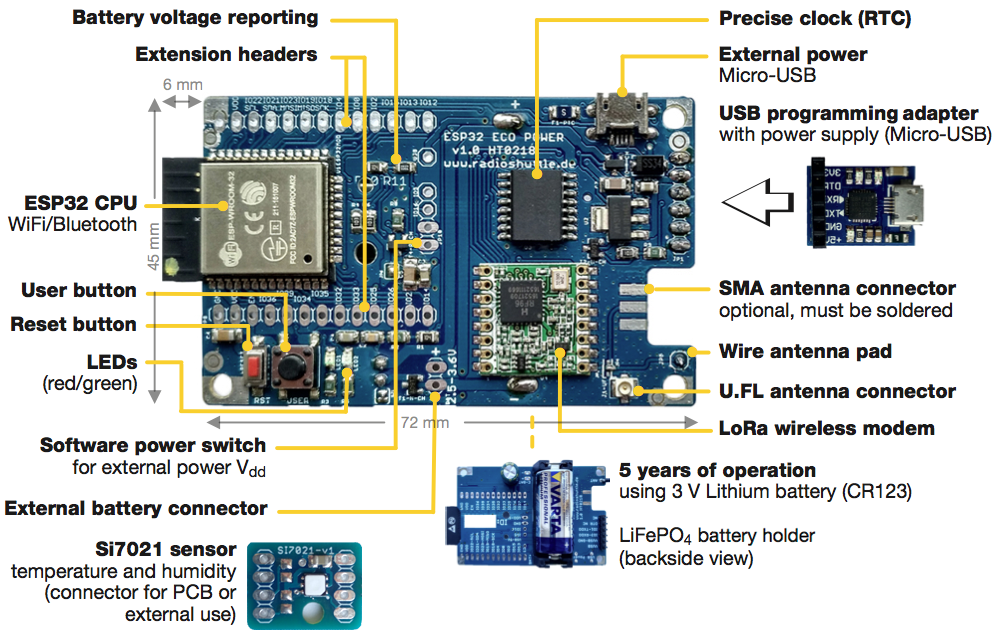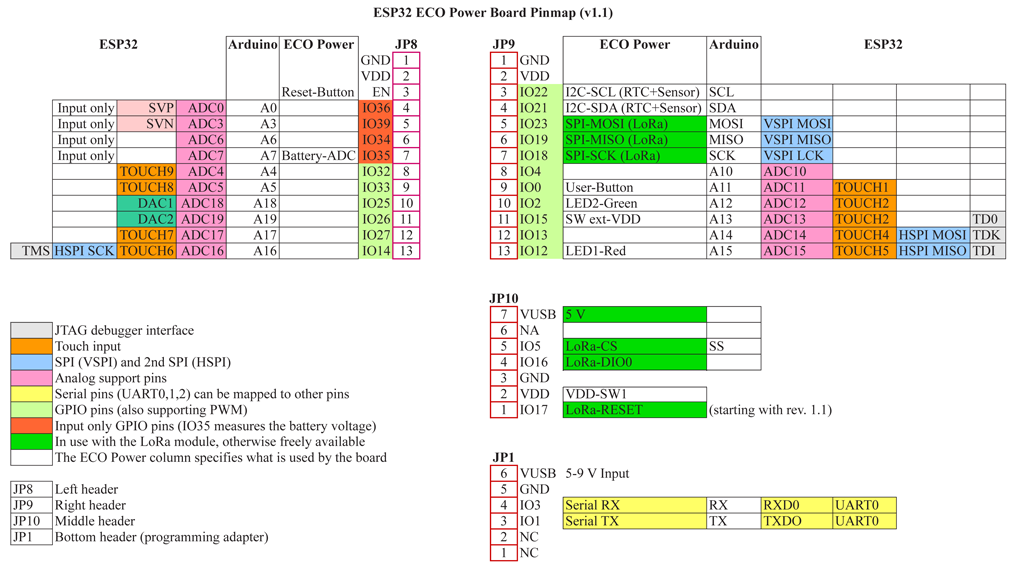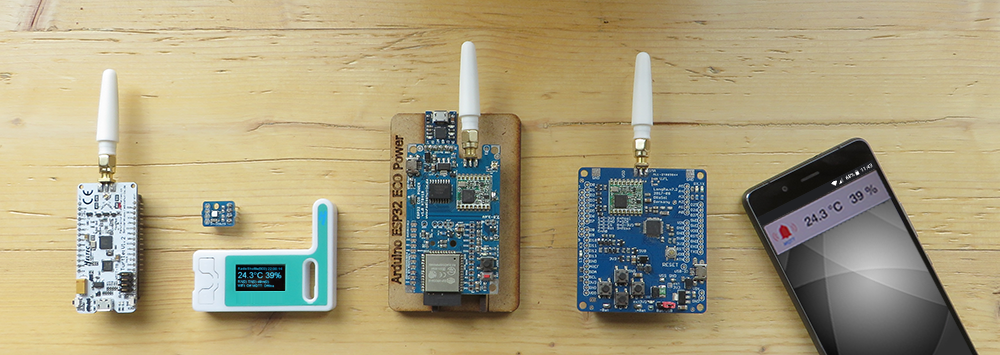
Due to great demand, the ESP32 ECO Power boards are currently not available! The production of new boards is in progress.
Turnkey ESP32 solution with LoRa
The turnkey ESP32-compatible board can be used immediately in the original Arduino environment. The included RadioShuttle radio protocol software enables node-to-node communication without additional routers and servers. The solution is designed for battery operation (CR123), but can also be operated with an external power supply. An enclosed temperature and humidity sensor can be plugged on or used externally. A slot allows individual hardware extensions. The integrated RTC module provides the exact time. Simply ingenious!
Computing power with ESP32 module
Our ECO Power board is built around an ESP32 processor (MCU) from Espressif Systems. With the included USB programming adapter, the board can be connected to a Windows, Linux or Mac computer via a USB port. Thanks to ESP32 compatibility, it is recognized as an “ESP32 Dev Module” in the Arduino IDE. Of course, the WiFi and Bluetooth functions of the ESP32 module can also be used.
LoRa radio module
As LoRa radio module we use the 868 MHz RFM95 transceiver module from HopeRF. It is specified for a maximum constant transmit power of +20 dBm or 100 mW, whereby in the EU we may not exceed an effective radiated power of +14 dBm. The achievable link budget, which roughly speaking represents the quality of the entire radio link with all losses and gains, is specified by the manufacturer as 168 dB. The LoRa chip on the RFM95 module is based on the Semtech SX1276 development.
The necessary signal lines of the RFM95 module are directly connected to the ESP32. This allows our RadioShuttle software to control the full functionality of the module. And there are no hardware restrictions in the development and testing of other radio protocols that stand in the way of creativity and experimentation.
All you need is a simple wire, which you solder to the board and tune yourself. If you want to install pre-assembled antennas, you will also find an existing U.FL socket and an SMA placeholder on the board, a solderable SMA socket is included in delivery. The antenna can be switched between wire antenna (standard), U.FL or SMA via solder bridges.
Flexible power supply
The operating voltage for the ECO Power board is 2.5-3.6 volts and can be supplied by a CR123 lithium or LiFePO4 cell. For this purpose, a battery compartment for the CR123 cell is permanently installed on the back of the board. Batteries or rechargeable batteries can be used here. This is particularly energy-saving and guarantees a long mains-independent operating time with a battery life of up to 5 years.
Alternatively, the board can also be completely powered via a micro-USB connection. If you want to use an external battery power supply, there is a separate input for the supply voltage (2.5-3.6 volts) on the board as battery power source or 5 volts on the programming adapter. The choice of power supply, battery or USB, is automatic, USB always has priority. If the USB power supply fails, the system automatically switches to battery or rechargeable battery.
For battery operation using intensive WiFi communication or other power-hungry consumers, it is worth using LiFePO4 batteries (capacity of approx. 500 mAh), as these can supply high currents at 3 volts and are rechargeable. Lithium batteries, e.g. Varta CR123 (3 V, 1700 mAh), are more suitable for power-saving operation, e.g. ECO Power board with LoRa and temperature sensor, as they can supply energy for many years. Simple AA/AAA batteries (e.g. 2 x 1.5 V AA) are not recommended, as they can quickly fall below the minimum required 2.5 volts, although there is still plenty of capacity. We therefore recommend lithium batteries or LiFePO4 batteries.
IO concept
The two rows of pin headers on the ECO Power board are signal compatible with the ESP32 module. Due to the extensive equipment of our board, various pins are already preassigned internally by the system. They are addressed in the source code in the same way as with the Arduino ESP32 and can partly also be used for own applications, see the “xPinMap.h” file and the connection diagram below for details. For common sensor nodes, sufficient digital, analog, serial and I²C connections are available in any case.
Note:
The ESP32 Espressif Systems can only tolerate a maximum of 3.6 volts. All signals higher than 3.6 volts must be reduced accordingly using a voltage divider.

On the left side of the board – antenna points to the right – is the ESP32 module with reset and user buttons as well as two LEDs (red and green). A current switch (VDD) allows external parasitic loads to be disconnected from the power supply. A p-channel MOSFET circuit is included for this purpose.
On the right side we have provided a pin row for the programming adapter, which is needed for the Arduino serial monitor and programming. The programming adapter supplies the board with power.
In RadioShuttle LoRa radio operation, the red LED lights up when transmitting and the green LED when receiving radio data. In addition, the green LED flickers every time the Arduino “Loop” passes through in order to make unwanted CPU activity visible. If necessary, the IO lines of the LEDs can also be repurposed. Pins are provided on the expansion slot for this purpose.
Precise RTC clock
An additional RTC clock is integrated on the board, as the ESP32 no longer provides a usable time in “deepsleep“ power-saving mode. The RTC clock is temperature compensated (TCXO) and runs very accurately for years. The RTC clock is calibrated against an atomic clock (standard 10 MHz reference via GPS) during the production of the ECO Power board to ensure optimum function.
Temperature and humidity sensor
The included sensor draws very little power (< 1 µA) in idle mode and allows a regular precise measurement of temperature and humidity. In order to use the sensor as flexibly as possible according to the requirements, it can be plugged onto the upper left of the board or under the board (pin header for soldering are included in delivery). Alternatively, the sensor can also be positioned externally with a cable. The software for reading out the sensor is integrated in the RadioShuttle software. Just plug it in and you’re done!
OLED display
See Operating the ECO Power board with an OLED display.
Energy management
As mentioned above, we have designed the board to be as energy efficient as possible to achieve a long battery life. This includes the use of high-impedance blocking MOSFETs for the power supply and switching functions as well as an overall low-current circuit design.
The RadioShuttle software supplied with the ECO Power board is adapted to this hardware. Through various energy-saving algorithms ranging from packet size optimization and automatic reduction of transmission power in good transmission conditions to the use of the “sleep” and “deepsleep” functions of the ESP32, they are an essential component of sophisticated energy management.
By using the RadioShuttle example software with integrated power saving function, this ESP32 LoRa solution makes it easy for everyone to set up battery-powered wireless sensors.
Scope of delivery
Listing of the individual parts included in the ECO Power delivery (per board):
- ESP32 ECO Power board with LoRa
- Programming adapter (attached to right side)
Note:
For a board order (3 items in a set) only two programming adapters are included.
- 2 x 13 pin extension headers (female header)
- Wire antenna (approx. 9 cm)
- 1 x 4 pin connector (male header)
- Si7021 sensor (temperature and humidity sensor)
- 2 x 1k resistor (SMD 0805)
- Optional: 1 x SMA connector for the board
- Optional: Wooden board holder
Only while stocks last, for the first orders!
The board can be placed on the holder to allow for a firm stand during development, measuring, and testing
For the first commissioning it is sufficient just to connect the antenna. The rest is optional and is described in the ECO Power documentation. A micro-USB connection cable is not included and must be purchased separately.
Continue with Commissioning
